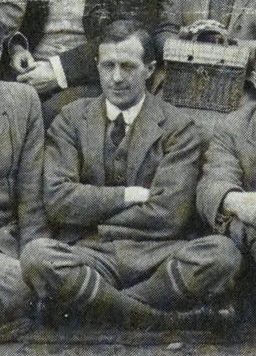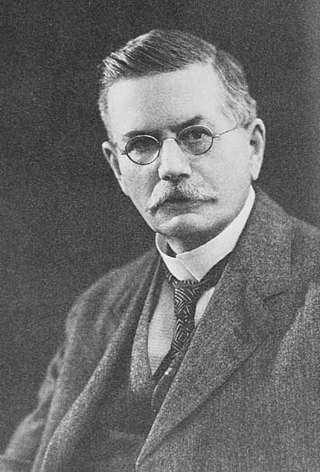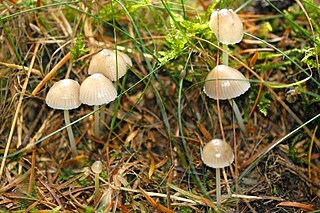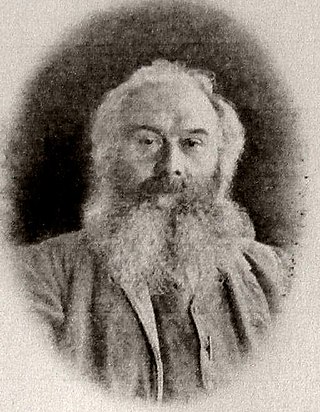
The British Mycological Society is a learned society established in 1896 to promote the study of fungi.

Jean Louis Émile Boudier was a pharmacist who lived in Montmorency, France. He published a fair amount about the Discomycetes and other areas of mycology. He often used Émile as his first name.

The peridium is the protective layer that encloses a mass of spores in fungi. This outer covering is a distinctive feature of gasteroid fungi.

Worthington George Smith was an English cartoonist and illustrator, archaeologist, plant pathologist, and mycologist.

George Edward Massee was an English mycologist, plant pathologist, and botanist.

Arthur Anselm Pearson was an English mycologist. He often published under the name A. A. Pearson. The standard author abbreviation A.Pearson is used to indicate this person as the author when citing a botanical name.

Reverend William Leigh Williamson Eyre was an English mycologist and naturalist.
The Woolhope Naturalists' Field Club is a society devoted to the natural history, geology, archaeology, and history of Herefordshire, England. Founded in 1851, it has had many notable members and played an important early role in the history of mycology in Britain.

Otidea is a genus of fungi in the family Pyronemataceae. The genus is widely distributed in northern temperate regions.

Thomas Petch was a prolific English mycologist and plant pathologist best remembered for his work on the interaction between fungi and insects.
Andrew Price Morgan was an American botanist. He investigated the flora of the Miami Valley in Ohio. While his interest included flowering plants, as noted by his Flora of the Miami Valley, Ohio, his special interest was in fungi. Morgan worked as a teacher in Dayton. He studied the botany of the Great Miami River, publishing in 1878 the Flora of the Miami River, Ohio; Morgan also showed particular interest in mycology and bryology. A.P. Morgan was a mentor to the prominent American mycologist Curtis Gates Lloyd. His correspondence with Lloyd is stored in the Lloyd Library and Museum in Cincinnati. Lloyds portion of the correspondence is stored in the Ada Hayden Herbarium at Iowa state university. Morgans collection of preserved fungi can also be found at the Ada Hayden Herbarium along with Laura Morgans gouache illustrations of fungi that could not be preserved.

Mycena olivaceomarginata is a species of agaric fungus in the family Mycenaceae. Originally described as Agaricus olivaceomarginata by English mycologist George Edward Massee in 1890, he transferred it to Mycena in 1893. Found in Europe and North America, the mycelium of the fungus is bioluminescent.

John Farrah, F.L.S., F.R.Met.S was a British grocer, confectioner, biologist and meteorologist from Harrogate, North Riding of Yorkshire, England. In the late 19th century he developed the business strategy for Farrah's toffee shop which he inherited from his family in Harrogate. He was made a fellow of the Meteorological Society in 1894. He was president of the botanical section of the Yorkshire Naturalists' Union, working with Thomas Sheppard, George Edward Massee, William Eagle Clarke and Charles Crossland, and in 1903 discovered the mycological species Entoloma farrahi, which was named after him, although there has been some question as to its identity since then. He was a close friend of Harrogate historian William Grainge and for some years they were "constant companions", supporting each other in their work. The American mycologist George Francis Atkinson described him as a "great Yorkshire character". Farrah married three times, and had three children.

William Norwood Cheesman was an English businessman and mycologist from Selby who contributed to studies on fungi and slime moulds as an amateur and founding member of the Yorkshire Naturalists' Union and the British Mycological Society. He contributed principally as a collector with most species described by others including George Edward Massee. The fungal species Coprinus cheesmanii, Cyphella cheesmanii, and Verticicladium cheesmanii were named after him.
Henry Thomas Soppitt was an English mycologist, plant pathologist, botanist and former greengrocer turned drysalter. He was a close collaborator with Charles Crossland, James Needham, and George Massee and was the first person to show a heteroecious lifecycle in a Puccinia species. Soppitt was a foundational member of the British Mycological Society.
The Yorkshire Mycological Committee is a committee within the Yorkshire Naturalists' Union. First formed in 1892, it was the first permanent organisation dedicated to the study of fungi in Great Britain. It was the principal founding organisation of the British Mycological Society.
The Yorkshire Naturalists' Union is an association of amateur and professional naturalists covering a wide range of aspects of natural history. It is one of United Kingdom's oldest extant wildlife organisations and oldest natural history federation. Its Mycological Committee, founded in 1892, is the oldest permanent organisation dedicated to the study of fungi in Great Britain.

James Needham was an English mycologist and iron moulder from Hebden Bridge, Yorkshire. He was a founding member of the British Mycological Society. Notable for his working-class status, Needham became one of the foremost collectors of fungi and bryophytes in the UK.

Ivy Massee was an English mycologist, scientific illustrator and botanist.
Edmund William Mason was an English botanist and mycologist, noteworthy for his research on the taxonomy of hyphomycetes.














